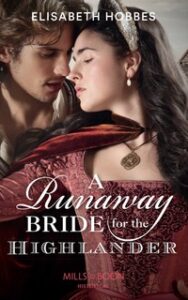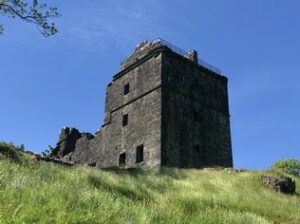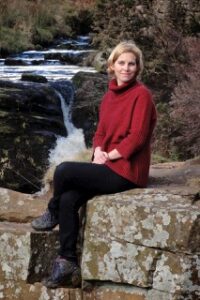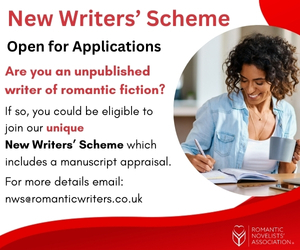Elisabeth Hobbes – How To Write A Convincing Castle
30 May 2019
I’d like to extend a very warm welcome to Elisabeth Hobbes today. Elisabeth is sharing the details of her exciting new release, A Runaway Bride for the Highlander, which forms part of the Lochmore Legacy series from M&B. We’ve heard from Janice Preston, and Lara Temple, and now the story is set to continue with this fabulous story.
Elisabeth, could you tell us a little more about how you went about establishing the setting for the stories?

The four books in the Lochmore Legacy series feature different couples in different ages. Secrets are gradually revealed as we travel back in time but each book can be read as standalone stories. There is, however, one important aspect that runs through the continuity. As well as creating four romantic couples and a mystery that spanned centuries, Janice Preston, Lara Temple, Nicole Lock and I were tasked with creating Lochmore Castle, the ancestral home of Clan Lochmore, and the setting for the four stories.
Our brief from Mills & Boon was that the clan were powerful and wealthy so the castle would be something along the lines of one of the many castles we’re all familiar with. We knew our castle needed to be close to the sea on a spit of land and had to have certain features that could have been adapted, renovated or added to over the years as the Lochmore family lived there.
We started looking for a real life castle to model ours on and pretty quickly settled on Harlech Castle as a possible candidate. Being the only member of the team in possession of a caravan and easy access to Wales I volunteered to go on a location scouting trip and duly packed the family up for an expedition.
Harlech Castle is stunning. Perched above the town, overlooking the sea, with a tide that goes out for miles leaving rocks and beaches, it had everything we needed, including a tunnel and sea gate to allow access to beaches and bring in supplies during sieges. I even managed to locate a chapel within the inner walls. Everything was going well until I stopped for a chat with the very welcoming and knowledgeable man in the gift shop. He asked why we were visiting and when I explained he dropped a bombshell that Scottish castles were a totally different style.
If you picture an archetypal castle, what does it look like? Thick, concentric curtain walls with crenulations and arrow slits? Towers at each corner and a central keep? Perhaps a moat and drawbridge?
Even a quick look at Scottish Castles shows they are often nothing like that (something we really should have looked into before I headed out). A vast number of Scottish castles were built as a result of feuds between clans such as the one between Lochmores and McCrieffs with a need for a stronghold. Estimates suggest there were once up to 3000 castles in Scotland! They were designed for domestic residence by a family as much as for defence and administrative centres for the clan chiefs and aside from royal castles – Edinburgh and Stirling – they tended to be smaller and less imposing than the English and Welsh examples, depending on the wealth and status of the owner. The early style of wooden towers with a curtain wall surrounding them gave way to the tower house style. This would consist of a residence, possibly a chapel and storerooms built from stone within a walled courtyard. Fortunately this difference in style and a smaller scale made it much easer for me to write the scenes where Ewan Lochmore returns home to find his home has been overrun by McCrieffs and discovers a devastating theft from [no spoilers- you’ll have to read it].
 Also fortunately for me, the start of the heatwave in 2018 coincided with the May half-term holiday so my family were more than happy to join me on another adventure to find inspiration. A combination of Castle Sween and Carnasserie Castle near Kilmartin finally provided accurate inspiration for the castle in my period, along with Dunvegan for the later books, and the headland around Crinan was the perfect location to set it.
Also fortunately for me, the start of the heatwave in 2018 coincided with the May half-term holiday so my family were more than happy to join me on another adventure to find inspiration. A combination of Castle Sween and Carnasserie Castle near Kilmartin finally provided accurate inspiration for the castle in my period, along with Dunvegan for the later books, and the headland around Crinan was the perfect location to set it.
We hope readers fall in love with our fictional castle as much as we did and forgive any goofs they spot.
Thank you, Elisabeth. It sounds like you had a marvellous trip investigating castles! Before you go, I’ve a few more questions for you if that’s okay?
The Tudor period is such an incredibly evocative era. How did you go about making sure that your setting for the story was accurate?
My story starts in Stirling at the coronation of King James V, then an infant of around 18 months old. I have the travel bug so decided it was the ideal opportunity to have a visit to Scotland and absorb the atmosphere, especially since I had to go on another castle hunt. We headed to Stirling to explore the castle, then (roughly) followed the route Ewan and Marguerite would have taken via Loch Lomond to end in Crinan, close to our fictional Lochmore Castle. We didn’t venture out on horseback but driving through the landscape and seeing lochs and mountains was wonderful inspiration for their journey. It would be a wonderful setting to fall in love in. I was all ready to pack up the family and move to Scotland until the midges descended and, like Marguerite, I found them insufferable.
As far as ensuring Lochmore Castle itself was consistent, this involved photos I had taken and Janice’s skills at drawing lots of colour-coded plans. An hour of downtime at the RNA conference in 2018 saw Janice, Lara and I poring over them in our kitchen with glasses of wine and discussing where tunnels should start and end.
What were the most difficult things to get accurate in the story? What other research did you engage with?
One of the things I quickly came to realise was how much of the focus on the 15th century is on English events. The period is generally referred to as the Tudor era but the Scots, ruled by the Stuarts, would have taken great exception to that. At the time of my story Scotland was still a separate country at war with England – in fact my hero, Ewan, becomes earl after the death of his father at the Battle of Flodden where Scotland suffered an overwhelming defeat.
The court of King James IV was by all accounts extremely sophisticated. He had ambitions to be viewed as a Renaissance prince so filled his court with philosophers, artists, musicians and alchemists and the style of clothing was French influenced. I would have loved to write about that (and the Italian alchemist who attempted to build wings and fly from the battlements). My heroine, Marguerite arrives from France expecting to be surrounded by this refinement but instead finds herself there shortly after James IV’s death at Flodden and instead is surrounded by grieving, angry men from all over Scotland so I ended up leaving out a lot of what I had discovered.
The other challenge was that Marguerite is my first French heroine so I had to research French clothing, customs and food from the period too. Marguerite is in mourning and I discovered that at the time of the story, the colour signifying this was white. This discovery led me to change the way Ewan first encounters her and include a fun bit of confusion. It’s probably the strangest meet-cute I’ve written.
And finally, you were the winner of the 2018 Elizabeth Goudge trophy presented at the RNA Conference. That must have been incredibly exciting. Could you tell us something about that?
Winning was certainly a surprise (though a wonderful one). I almost didn’t enter at all but once I had the opening line in my head it wouldn’t leave. I assumed, given how many talented writers I knew would have entered, I didn’t stand a chance so I didn’t even have my shoes on (it was so hot in the dining room) and had to scrabble about for them underneath the table. The trophy is in a shelf of my writing desk where I can look at it any time I’m feeling doubtful that I can write.
I was overjoyed with the response my entry had when it was published in Romance Matters back in December. For anyone who missed it in the winter issue, the story was about a woman who rescues a baby girl found floating out to sea, and the mysterious man who comes to claim her back. I’m planning to develop it into a full manuscript when I have the space between other commitments. I’d like to have something to share with agents and editors at the conference this year.
Thank you again for joining us, Elisabeth. Good luck with the book!
About the Author:
 Elisabeth’s writing career began when she finished in third place in Harlequin’s So You Think You Can Write contest in 2013. She was offered a two-book contract and hasn’t looked back. Since then she has published seven Medieval romances with Harlequin Mills & Boon.
Elisabeth’s writing career began when she finished in third place in Harlequin’s So You Think You Can Write contest in 2013. She was offered a two-book contract and hasn’t looked back. Since then she has published seven Medieval romances with Harlequin Mills & Boon.
Elisabeth is a Primary school teacher but she’d rather be writing full time because unlike five year olds, her characters generally do what she tells them. When she isn’t writing, she spends most of her spare time reading and is a pro at cooking one-handed while holding a book. She loves historical fiction and has a fondness for dark haired, bearded heroes.
Elisabeth enjoys skiing, singing, and exploring tourist attractions with her family. Her children are resigned to spending their weekends visiting the past. She lives in Cheshire because the car broke down there in 1999 and she never left.
https://twitter.com/ElisabethHobbes
https://www.facebook.com/ElisabethHobbes/
About the Interviewer
 Ruby Moone lives in the wilds of Lancashire with her husband and writes historical and contemporary romance. At school, her teachers said that she lived with her head in the clouds and if she didn’t stop daydreaming she would never get anywhere. She never did stop daydreaming, and after years of happily living in the clouds, decided to write the stories down.
Ruby Moone lives in the wilds of Lancashire with her husband and writes historical and contemporary romance. At school, her teachers said that she lived with her head in the clouds and if she didn’t stop daydreaming she would never get anywhere. She never did stop daydreaming, and after years of happily living in the clouds, decided to write the stories down.
https://www.facebook.com/RubyMoone/
https://twitter.com/RubyMooneWriter
https://www.instagram.com/rubymoone/



